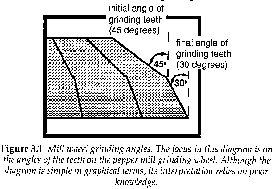How diagrams are usually developed
The events in the collaboration between a subject matter expert and a graphics professional:
1 The subject matter expert is the author of the instructional materials:
- develops a manuscript,
- produces instructions concerning manuscripts,
- gathers examples of diagrams to indicate the type of diagram required,
- gathers other forms of artwork (photographs), from which diagrams are to be prepared,
- describes the contents of the diagrams,
- describes the general type of diagram.
2 The artwork specifications are given to the artist(s).
3 The artwork goes thru several drafts - author and artist interacting.
To keep development time low, the author has to be as specific as possible.
The author makes clear to the artist what the diagram
should be trying to do and why.
It is a good idea to present information for each diagram in several formats.
Ill-defined specifications often result in time consuming back and forth process.
For the graphic aspects, the artists can mobilize their experience, expertise and visual creativity.
An instructional designer can facilitate and improve this process.
Dangers when including diagrams
What is the main justification for including diagrams?
If the only reason for using diagrams are similar to these,
some serious rethinking needs to be done:
Pictures provide relief in breaking up the text.
Students find pictures more approachabel than text.
Pictures are more effective in instruction than text: explains better, intrinsically more memorable.
Since we live in a highly visually oriented world,
learners are especially well attuned to processing pictorial information.
Visual forms of presentation are highly effective in capturing and maintaining the attention.
Learners who have trouble learning from text find in pictures an alternative means of access to the subject matter.
Instructional resources with a lot of pictures are better sold than largely text based materials.
A diagram must make a worthwhile contribution to learning.
Like the text has to be well focused on the topic and carefully written,
the diagram must be constructed with expertise to contribute to learning:
- with well-defined instructional objectives,
- assuming a positive function as part of the overall instructional resource.
It is a good idea to devise a written justification for a diagram
that is to be used as part of the instruction and to have a colleague play devil's advocate.
What should diagrams present?
When in doubt, throw it out!
The magic number of seven plus or minus two pieces:
limit the amount of information presented to between five an nine individual pieces.

If we want to show the angle of the teeth, only the wheel and it's teeth need to be shown.
And the teeth could be represented as single angled lines.
This diagram is simple in graphical terms, but requires quite a sophisticated process to be read.
The viewer must deal with the meaning of the pieces of information as well as how many are presented.
The viewer must fill in a lot of informational gaps in the depiction:
- Parts that are normally hidden from view.
- Insufficient context does not give enough clues about relations.
- Only part of the object shown makes it difficult to identify it.
- Removing subtle graphic characteristics (visual clues) makes the object more difficult to identify.
- The diagram isolates particular quantitative characteristics of the object.
- Explanatory additions require appropriate interpretation.
The conflicts:
Trying to obtain graphic simplicity vs. making the subject matter meaningful.
Providing the viewer with ways to make sense vs.
keeping the very directness that gives a simple diagram its explanatory potential.
Fundamental requirement:
Viewers can easily determine what they are looking at in a diagram:
- the identity of the general subject matter,
- the instructional purpose,
- the relative viewing position,
- the focus of the diagram (whole thing or a part),
- the ways in which the diagram differs from real-life situation.
The instructional designer needs to relate a particular diagram to the material that precedes it,
is associated with it and which follows it:
a great deal of care should be given to the context in which each diagram is presented.
A diagram's instructional context
Levels of context:
- immediate context of surrounding text
- more distant context of related material
- context of instructional resource as a whole
- broad context of the task and instructional setting



